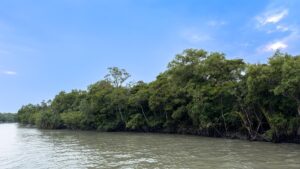GS 3 – Science and technology

Context
- A recent study by IISER Kolkata (published in FEMS Microbiology Letters) reveals that microbial communities in the Sundarbans possess genes that can degrade plastics.
- However, these microbes also carry antibiotic resistance genes (ARGs) and metal resistance genes (MRGs), raising concerns about antimicrobial resistance (AMR).
Key Findings
- Plastic Degradation Potential
- Sundarbans’ floating bacterial community contains hundreds of genes to degrade multiple plastic polymers.
- Metagenomic sequencing detected 838 plastic-degrading enzyme (PDE) hits acting on 17 polymers.
- Most abundant: Polyethylene glycol (PEG)-degradation enzymes → contamination likely from biomedical & industrial sources.
- Plastic-degrading enzyme abundance peaked during monsoon (nutrient & microplastic influx from rivers).
- Link with Antibiotic & Metal Resistance
- Microbes with PDE genes also carried ARGs and MRGs.
- Common: Aminoglycoside resistance and zinc resistance genes.
- Network analysis showed strong associations between PDEs, ARGs & MRGs.
- Suggests co-selection pressure from plastics, additives, metals & pollutants.
- Plastic & Microbes as Hotspots for Resistance
- Plastics break into microplastics (<5 mm) and nanoplastics (<1 µm), persisting for decades.
- These particles absorb antibiotics, metals & chemicals, providing surfaces for bacteria to thrive.
- Microplastics act as hotbeds where resistance genes accumulate & spread via horizontal gene transfer.
Implications
- Positive:
- Microbial adaptation shows potential for natural bioremediation of plastic pollution.
- Could offer eco-friendly solutions to plastic waste management.
- Negative / Risks:
- Plastic-degrading microbes may amplify antimicrobial resistance.
- Deliberate use of such microbes in the environment risks public health.
- Climate change could accelerate ARG transfer, affecting One Health.
Sundarbans Significance
- World’s largest mangrove forest, spanning India & Bangladesh.
- Receives ~3 billion microplastic particles daily via rivers flowing into Bay of Bengal.
- Serves as a natural laboratory for studying plastic pollution–microbe interactions.




